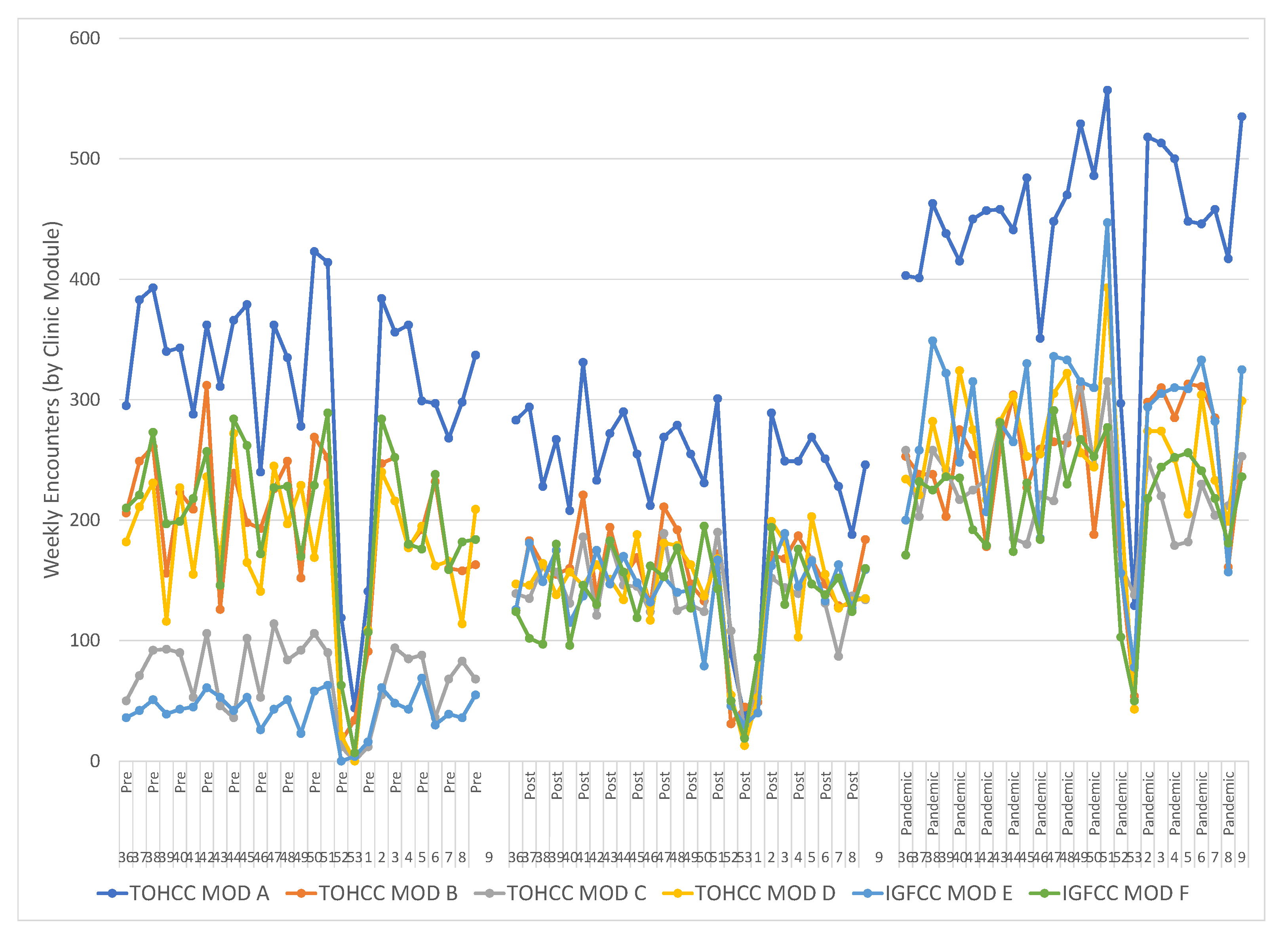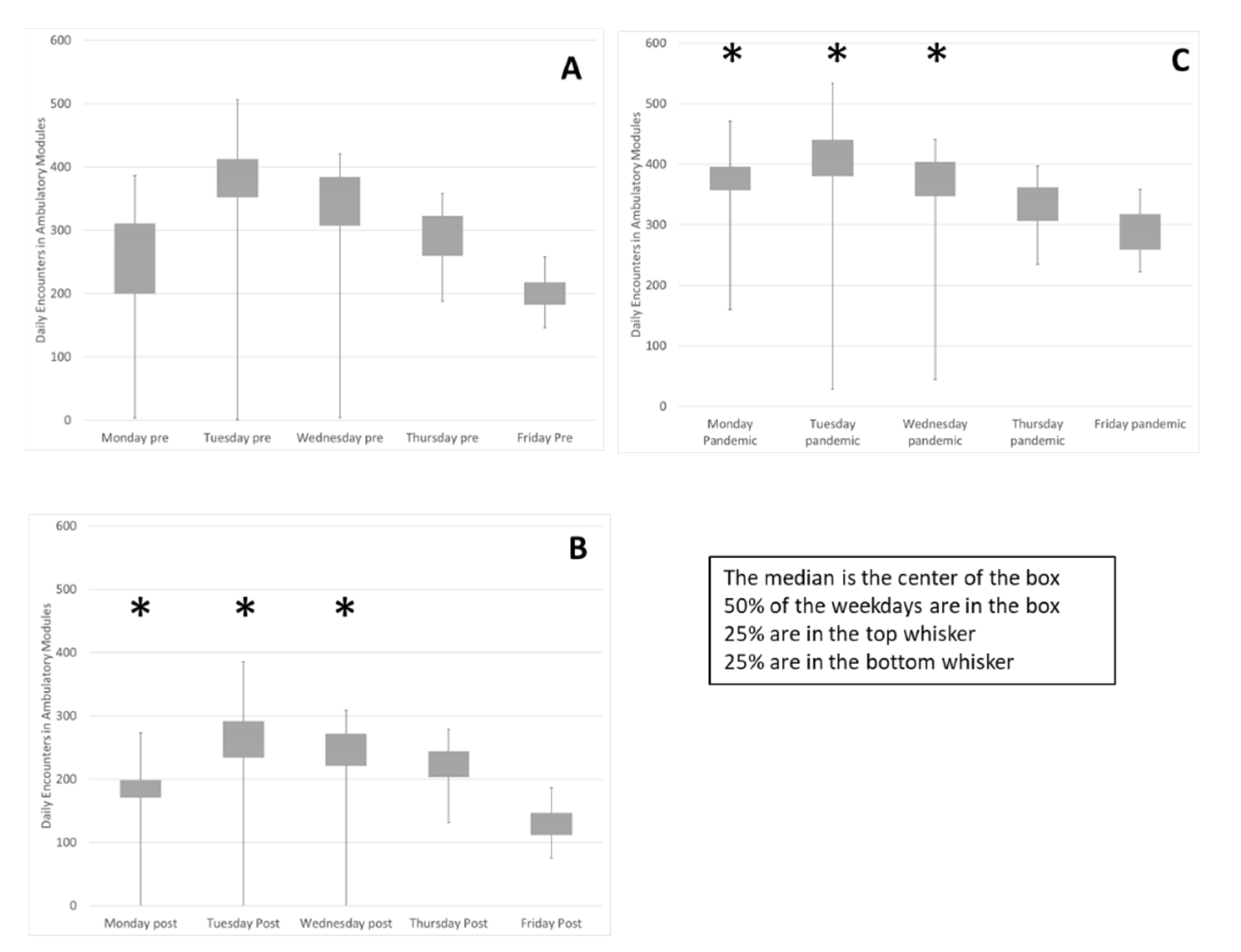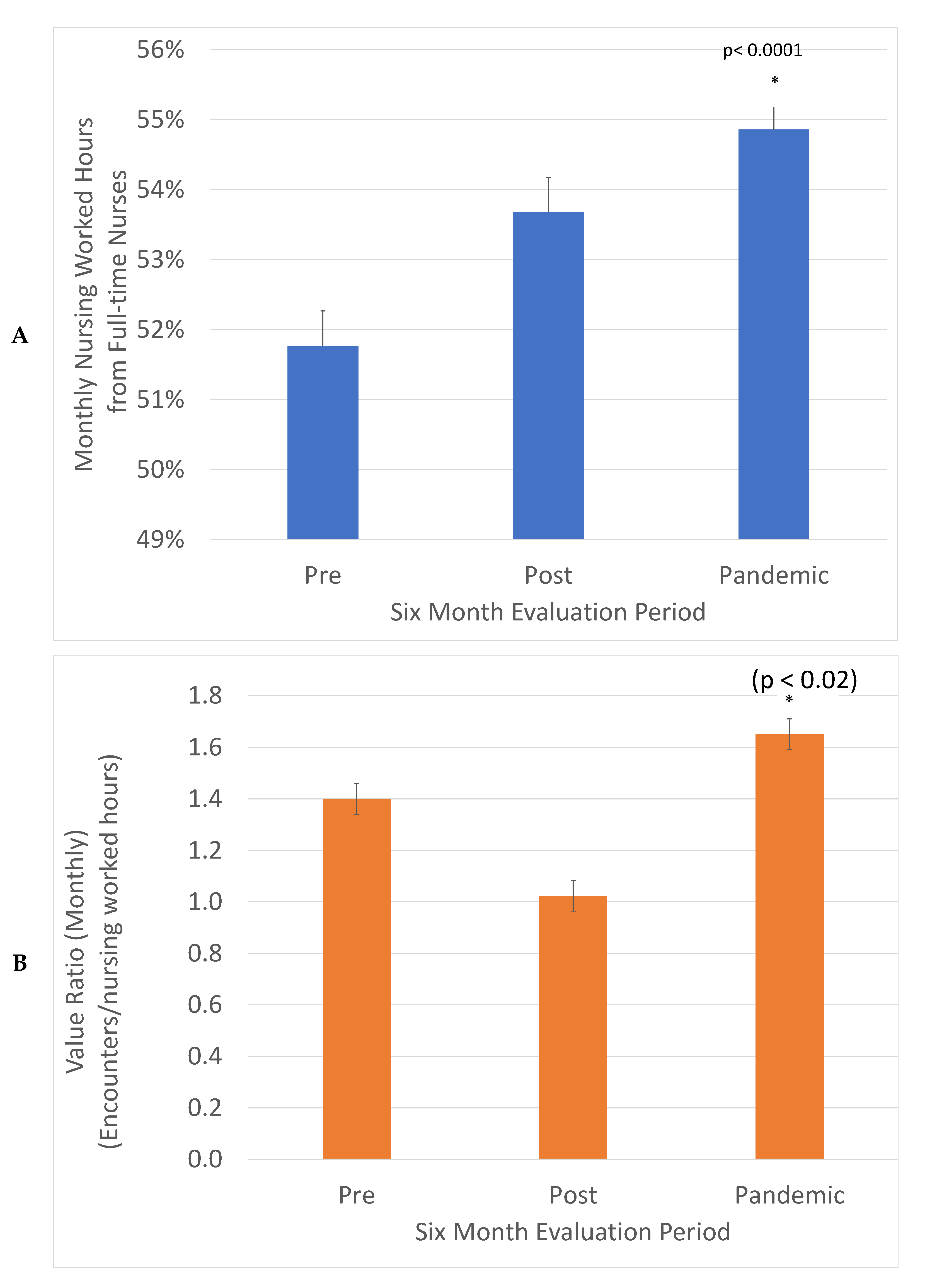Cancer Clinic Redesign: Opportunities for Resource Optimization
Abstract
:1. Introduction
Defining the Problem
2. Methods: Description of the Initiative
2.1. Five Key Elements in Block Schedule Design
- Converted service delivery and provider capacity into common units of disease site service minutes.
- Reviewed current allocation and identified disparities in resource alignment.
- Created a quarterly predictive model, including capacity for unexpected demand, to coordinate provider availability within disease sites.
- Active visibility of future gaps in service or constraints in resources supports dynamic allocation of unused capacity.
- Development of disease site home-bases that aggregate individual practices with nursing and clerical resources, reinforcing the disease site team approach.
2.2. Demand/Capacity Analysis
2.3. Block Schedule and Operational Margin
3. Results
3.1. Operational Need for Quarterly Block Schedule for Oncology Clinic
3.2. Removing Barriers to Change: Advanced Access Scheduling
3.3. Pre-Implementation Preparation: Demand Capacity Assessment
3.4. Launch of Quarterly Block Schedule
- By creating a specific capacity to meet the regional service demand, the clinic budget became tied directly to patient demand for specific services.
- The clinic budget is not impacted if providers enter or depart. Total services planned remain stable and the provider team can determine staffing strategies.
- Interdisciplinary clinics are planned in advance to desired volume and staffed within a defined envelope.
- Scheduling into the block schedule quarterly provides a structured method to adjust to current conditions in demand and capacity, including personnel issues.
- Creating the capacity to repurpose available clinic shifts supports the expected behavior of providers and enables swapping of clinic capacity within a defined overall budget.
- The model increased consistency of operations, promoting a larger percentage of full-time staff that are well-utilized during all shifts.
- The schedule clusters interdisciplinary teams around groups of patients and promotes timely, responsive, patient-centered care as well as a provider work-life balance.
3.5. Outcome Evaluation
4. Discussion
4.1. Operational Excellence through Caseload Management by Disease Site
- Support care continuity for patients and their provider team within the context of disease site group accountability for regional service demand.
- Reformat teams and supporting structures to support this disease site accountability, including nursing allocation and clerical resources.
- Support allocation of resources according to patient acuity by identifying patient segments with different care needs.
- Acknowledge need for quarterly iterative reset to plan human resource staffing and any necessary change to services due to patient demographics or medical science.
- Integrate these concepts into a framework of caseload management by disease site at the individual practice, disease site group and program management levels.
4.2. Change Management
4.3. Adaptability, Pandemic, Virtual Care, Technology, Future Directions
5. Conclusions
Author Contributions
Funding
Institutional Review Board Statement
Informed Consent Statement
Data Availability Statement
Acknowledgments
Conflicts of Interest
References
- King, M.; Jones, L.; Nazareth, I. Concern and Continuity in the Care of Cancer Patients and Their Carers: A multi-Method Approach to Enlightened Management; National Co-ordinating Centre for NHS Service Delivery and Organisation R&D (NCCSDO): London, UK, 2007. [Google Scholar]
- Gorin, S.S.; Haggstrom, D.; Han, P.K.J.; Fairfield, K.M.; Krebs, P.; Clauser, S.B. Cancer Care Coordination: A Systematic Review and Meta-Analysis of Over 30 Years of Empirical Studies. Ann. Behav. Med. 2017, 51, 532–546. [Google Scholar] [CrossRef] [PubMed] [Green Version]
- Fung-Kee-Fung, M.; Maziak, D.E.; Pantarotto, J.R.; Smylie, J.; Taylor, L.; Timlin, T.; Cacciotti, T.; Villeneuve, P.J.; Dennie, C.; Bornais, C.; et al. Regional process redesign of lung cancer care: A learning health system pilot project. Curr. Oncol. 2018, 25, 59–66. [Google Scholar] [CrossRef] [PubMed] [Green Version]
- Margolis, P.A.; Peterson, L.E.; Seid, M. Collaborative Chronic Care Networks (C3Ns) to transform chronic illness care. Pediatrics 2012, 131, S219–S223. [Google Scholar] [CrossRef] [PubMed] [Green Version]
- Grossman, C.; Goolsby, W.A.; Olsen, L.; McGinnis, J.M. (Eds.) Engineering a Learning Healthcare System: A Look at the Future; National Academies Press: Washington, DC, USA, 2011. [Google Scholar]
- National Health Service. The Learning Healthcare Project. Available online: http://www.learninghealthcareproject.org/ (accessed on 21 February 2017).
- Institute of Medicine. Best Care at Lower Cost: The Path to Continuously Learning Healthcare in America; Institue of Medicine: Washington, DC, USA, 2012. [Google Scholar]
- Sullivan, T. Improving quality and performance in Ontario’s cancer services: Lessons for constructing a learning healthcare system. Healthc Q. 2015, 17, 5–9. [Google Scholar] [CrossRef] [PubMed]
- Ontario Health (Cancer Care Ontario). Ontario Cancer Statistics 2020; Ontario Health (Cancer Care Ontario): Toronto, ON, Canada, 2020; ISBN 978-1-4868-3681-9. ISSN 2371-0403. [Google Scholar]
- Stewart, D.J.; Maziak, D.E.; Moore, S.M.; Brule, S.Y.; Gomes, M.; Sekhon, H.; Dennie, C.; Lo, B.; Fung-Kee-Fung, M.; Bradford, J.P.; et al. The need for speed in advanced non-small cell lung cancer: A population kinetics assessment. Cancer Med. 2021, 10, 9040–9046. [Google Scholar] [CrossRef] [PubMed]
- Froehle, C.M.; Magazine, M.J. Improving Scheduling and Flow in Complex Outpatient Clinics. In Handbook of Healthcare Operations Management: Methods and Applications; Springer: New York, NY, USA, 2012; pp. 229–250. [Google Scholar]
- Saville, C.E.; Smith, H.K.; Bijak, K. Operational research techniques applied throughout cancer care services: A review. Health Syst. 2018, 8, 52–73. [Google Scholar] [CrossRef] [PubMed] [Green Version]
- Lin, C.K.Y.; Ling, T.W.C.; Yeung, W.K. Resource Allocation and Outpatient Appointment Scheduling Using Simulation Optimization. J. Healthc. Eng. 2017, 2017, 19. [Google Scholar] [CrossRef] [PubMed] [Green Version]
- Ahmadi-Javid, A.; Jalali, Z.; Klassen, K.J. Outpatient appointment systems in healthcare: A review of optimization studies. Eur. J. Oper. Res. 2017, 258, 3–34. [Google Scholar] [CrossRef]
- Strum, D.P.; Vargas, L.G.; May, J.H. Surgical Subspecialty Block Utilization and Capacity Planning: A Minimal Cost Analysis Model. Anesthesiology 1999, 90, 1176–1185. [Google Scholar] [CrossRef] [PubMed]
- Santibáñez, P.; Begen, M.; Atkins, D. Surgical block scheduling in a system of hospitals: An application to resource and wait list management in a British Columbia health authority. Health Care Manag. Sci. 2007, 10, 269–282. [Google Scholar] [CrossRef] [PubMed]
- Allen, J.M. Optimizing Surgical Block Time. Blog: The Hospital Medical Director. October 2018. Available online: http://hospitalmedicaldirector.com/optimizing-surgical-block-time/ (accessed on 25 May 2022).
- NHS Institute for Innovation and Improvement. Demand and capacity—A Comprehensive Guide. 19 November 2020. Available online: https://webarchive.nationalarchives.gov.uk/ukgwa/20121116070602/https://www.institute.nhs.uk/quality_and_service_improvement_tools/quality_and_service_improvement_tools/demand_and_capacity_-_a_comprehensive_guide.html/ (accessed on 25 May 2022).
- Patrick, J.; Puterman, M.L. Reducing Wait Times through Operations Research: Optimizing the Use of Surge Capacity. Healthc. Policy 2008, 3, 75–88. [Google Scholar] [PubMed] [Green Version]
- Agency for Healthcare Research and Quality. Strategy 6A: Open Access Scheduling for Routine and Urgent Appointments. 2017. Available online: https://www.ahrq.gov/cahps/quality-improvement/improvement-guide/6-strategies-for-improving/access/strategy6a-openaccess.html (accessed on 25 May 2022).
- Friedman, C.; Rubin, J.; Brown, J.; Buntin, M.; Corn, M.; Etheredge, L.; Gunter, C.; Musen, M.; Platt, R.; Stead, W.; et al. Toward a science of learning systems: A research agenda for the high-functioning Learning Health System. J. Am. Med. Inform. Assoc. 2015, 22, 43–50. [Google Scholar] [CrossRef] [PubMed] [Green Version]
- Greene, S.; Reid, R.; Larson, E. Implementing the learning health system: From concept to action. Ann. Intern. Med. 2012, 157, 207–210. [Google Scholar] [CrossRef] [PubMed]
- Abraham, E.; Blanco, C.; Lee, C.; Christian, J.; Kass, N.; Larson, E.; Mazumdar, M.; Morain, S.; Newton, K.; Ommaya, A.; et al. Generating Knowledge from Best Care: Advancing the Continuously Learning Health System; National Academy of Medicine. September 2016. Available online: https://nam.edu/generating-knowledge-from-best-care-advancing-the-continuously-learning-health-system/ (accessed on 25 May 2022).
- Smith, M.; Saunders, R.; Stuckhardt, L.; McGinnis, J.E. Best Care at Lower Cost: The Path to Continuously Learning Health Care in America; National Academies Press: Washington, DC, USA, 2013. [Google Scholar]
- Fung-Kee-Fung, M.; Boushey, R.; Watters, J.; Morash, R.; Smylie, J.; Morash, C.; DeGrasse, C.; Sundaresan, S. Piloting a regional collaborative in cancer surgery using a “community of practice” model. Curr. Oncol. 2014, 21, 27–34. [Google Scholar] [CrossRef] [PubMed] [Green Version]



| Aspect | Standing Template Model | Block Schedule Model |
|---|---|---|
| Physician attendance | Oncologists in clinic 40 weeks/yr, variable mix planned and unplanned absences | Oncologists in clinic 40 weeks/yr, variable mix planned and unplanned absences |
| Physician planning | Each physician has standing template of weekly clinics and cancels unwanted shifts | Each physician defines expected quarterly schedule in advance within total division footprints |
| Workload around vacation | Constant churn of physicians requesting makeup clinics before and after absences | Total quarterly clinics planned, aligned to annual goals, then swapped as necessary |
| Access to consult | Variable capacity depending on template occupancy | Consult clinics reassigned to available providers to maintain access |
| Workload and cost of staffing | Constant shuffling of nursing and clerical staff between scheduled, cancelled and makeup clinics, vacation/sick calls, unstructured office time | Staffing planned quarterly and shuffling only needed for last minute absences, patient navigation time scheduled and structured. |
| Physician oversight | Annual physician reappointment meetings to discuss career goals, disease site professional focus areas | Quarterly opportunity to adjust match between demand and capacity, align to annual goals |
| Budget control, clinic allocation | Budget and space concerns if new providers join team, competition for Tuesdays, slow Fridays | No change to budget or space when new providers join total services aligned to regional demand, more providers can utilize Tuesday and Friday clinics |
| Alignment demand/ capacity for patient groups | Unclear match rarely updated between regional demand for specialized services and allocated resources | Regional demand for specialized services assessed and allocated as quarterly target for delivery |
| Interdisciplinary clinics | Difficult to plan consistent interdisciplinary clinics | Clinics allocated sessions of resources and staffed by process within team |
| Parameter | Pre | Post | Pandemic |
|---|---|---|---|
| Interval | September 2018–February 2019 | September 2019–February 2020 | September 2020–February 2021 |
| Mean | 995 | 937 | 1670 |
| Standard Error | 60 | 48 | 65 |
| Median | 1019 | 999 | 1714 |
| Standard Deviation (SD) | 310 | 250 | 331 |
| Minimum | 89 | 169 | 492 |
| Maximum | 1339 | 1167 | 2265 |
| Sum | 26,866 | 25,294 | 43,431 |
| t-Test for Means, p Value compared to Pre period | N/A | >0.05 | <0.0001 |
| Coefficient of Variation (SD/mean) | 0.31 | 0.27 | 0.20 |
Publisher’s Note: MDPI stays neutral with regard to jurisdictional claims in published maps and institutional affiliations. |
© 2022 by the authors. Licensee MDPI, Basel, Switzerland. This article is an open access article distributed under the terms and conditions of the Creative Commons Attribution (CC BY) license (https://creativecommons.org/licenses/by/4.0/).
Share and Cite
Fung-Kee-Fung, M.; Ozer, R.S.; Davies, B.; Pick, S.; Duke, K.; Stewart, D.J.; Reaume, M.N.; Ward, M.; Balchin, K.; MacRae, R.M.; et al. Cancer Clinic Redesign: Opportunities for Resource Optimization. Curr. Oncol. 2022, 29, 3983-3995. https://doi.org/10.3390/curroncol29060318
Fung-Kee-Fung M, Ozer RS, Davies B, Pick S, Duke K, Stewart DJ, Reaume MN, Ward M, Balchin K, MacRae RM, et al. Cancer Clinic Redesign: Opportunities for Resource Optimization. Current Oncology. 2022; 29(6):3983-3995. https://doi.org/10.3390/curroncol29060318
Chicago/Turabian StyleFung-Kee-Fung, Michael, Rachel S. Ozer, Bill Davies, Stephanie Pick, Kate Duke, David J. Stewart, M. Neil Reaume, Marcus Ward, Katelyn Balchin, Robert M. MacRae, and et al. 2022. "Cancer Clinic Redesign: Opportunities for Resource Optimization" Current Oncology 29, no. 6: 3983-3995. https://doi.org/10.3390/curroncol29060318





